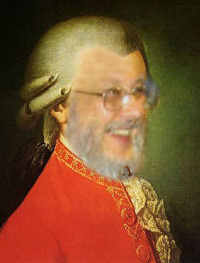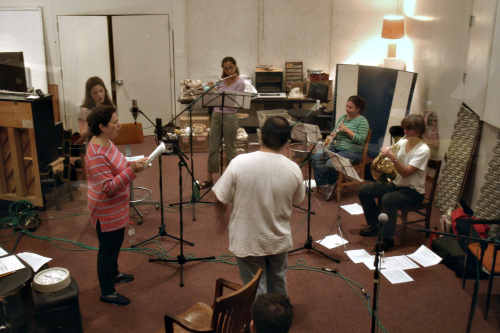A 365-Day Project
"We Are All Mozart"
A project to create
new works and change
the perception of the
music of our time.


 August 9, 2006
August 9, 2006 
I admit it. At this moment I am watching Project Runway. It's the only reality show that's ever caught my attention, and its surprising integrity and well-defined purpose were in part responsible for the creation of Komposer Kombat that was Kalvos & Damian's finale. In fact, it was what gave me confidence to embark upon the We Are All Mozart project.
For those of you who haven't seen this show, Project Runway is a competition among fashion designers to create an outfit or 'look' based on sometimes absurd assignments. The time is limited, the materials restricted, and the results presented as a miniature runway show. Yeah, if you're not into fashion, you're glazing over right now. I thought that would happen to me until I watched these designers take nothing, literally nothing but an idea, and drive it through minimal materials -- sometimes $100 worth, sometimes the contents of their shared hotel suite -- into a convincing and useful dress or skating outfit or competition gown or sportswear that can also be a work of art.
The program is often over the top because it's meant as an entertainment. At the same time, the intensity and dedication of the designers is not faked as they struggle with short-term assignments from which they will continue or be bounced from the show. That is the public tension -- who is in and who is out. But the parallel artistic tension is the invention of an idea from a mere suggestion, and the subsequent execution of that invention at a high level of craft. In their competitiveness they do not sacrifice meaning.
When David Gunn and I developed the Komposer Kombat framework, it was just as tight -- even tighter. In three hours, composers were to take the just-announced specifications and invent and execute a composition, whether electroacoustic or acoustic. The orchestration and length were required for the acoustic pieces; the use of a provided sample was required for each electroacoustic submission. (Look down this page for the rules.)
It would have been wonderful to have all those composers in video range, to see how they worked and how they solved the problem of using flute, oboe, horn and two sopranos, or integrating the short samples from my personal library.
What I learned from "K2" is summed up here:
|
Not that we ever learn much with our hard heads, but we did find out that people take competitions very seriously, even if they're warned off that idea. But fortunately, most of the participants -- composers, performers and judges -- kept the good humor in mind. They looked for every excuse to vote compositions off the island ... and found them. Our mistake was once again taking on too much, and if the gods of composition hadn't smiled on us, it would have been a disaster. The network was active and fast. The audio worked. The composers got their electroacoustic pieces and acoustic scores through to us -- even if Miriam had a software failure and Claudio had a power failure. The perfomers all showed up. The clinch conductor was spectacular. The microphones worked. The engineer was on top of it all. The broadcast started and ended on time. The transmitter and streams stayed active. No one broke down, freaked out, or got sick. K2 was everything we could have asked for, but the stress informed us that next time -- when we take this K2 project on the road, and yes we will -- we'll have to prepare better and be ready for emergencies. The single greatest flaw was composers writing beyond the time allotted and resources available, considering we all knew it would be single acoustic round early in the day. Several composers wrote pieces which asked something not possible within a single daytime reading -- such as difficult-to-read layout, important missing details without which a piece couldn't work (Kalvos forgot an important senza vib on his voice lines), weak or incorrect handling of ranges that included tessituras not achievable before the evening, and most crucially, complex or missing instructions. All the pieces were expertly created, but in the stress of time, almost every composer left out aspects of a score that would have made it instantly readable and musical. But what we learned the most is the the NonPop Revolution is so well underway that we can happily participate once again as composers ourselves. |
In retrospect, we learned even more beyond these technical flaws of organization or the enthusiasm for competitions. We discovered an enormous wellspring of ability and craft as well as what, for lack of a better term, we might call inspiration. Forty-one pieces were created from those simple rules, and aside from the "manifolds" done by James Bohn, no two were even a hair alike. I began to wonder about those who did not participate. There were philosophical objections and practical ones, schedule conflicts and lack of interest.
But what if the objectors overcame their reluctance, if the schedules coincided? It intrigues me to know what musical thoughts were stirred by those who ultimately did not participate. Did they daydream, even a little, about what they might have written? Were there but a few seconds of possibility? The morning glories were in full bloom during those two days last September, and for days before & after. Did the plants consider not blooming one of those days? Was there a day when they had no flower ideas?
Having been through the composer productivity survey responses many times, I daydreamed about those who, like Debussy, could not write a piece in only a few months because it took him "that long just to decide between two chords." What if he had been hurried? What surprises would we have heard? A composer of craft can work quickly enough. I have before me a preview copy of a new piece by Noah Creshevsky, based on vocal samples of the voice of Chris Mann (who voice also served as the source of the 121 compositions in The Frog Peak Collaborations Project). From concept to completion -- I was privileged to follow the progress long-distance -- this eight-and-a-half-minute composition demanded four months, most of it recording, sampling, and cataloging source elements. But once the library was built, the composition seemed to be pushed forward by great waves of ideas. The result is a delicate and meticulous set of continuous miniatures.
In effect, after the library of sounds was organized, the composition of Noah's new piece Free Speech was done quickly. For acoustic composers, the source sounds are part of their milieu. There is no struggle to collect sounds -- at best, they may invent a technique or two, but the greater part of new composition of dot-music is the organization of existing sonic threads into new weaves. Few composers are spinning spools of thread anew. Is the very ordinariness of acoustic sound the reason composers must struggle mightily? To overcome the ennui of yet another violin?
To the survey of composer productivity eighty-five composers responded. Of them, only fifteen composed more than ten pieces in an average year. Think about that. And this: Only ten wrote more than two hours of music in an entire year. It is a concept that escapes me entirely. If a composer is responsible for creating the electroacoustic source ensemble every time, that self-limitation makes some sense, though I would expect many studies to spin out of it. James Bohn, whom I've mentioned, creates manifolds. I like the term, and have adopted it. My Glossolalia series of electroacoustic manifolds has run to more than twenty. But acoustic music? Where is the blockage?
Oh, I've lost you. I'm just talking numbers, an affront to the concept of art. And yes, maybe that is so. My interest in increasing visible productivity is in bringing the idea of the composer into the world of, if you will, teachers and journalists and improvisers and illustrators and the many other creative beings who make new work every day of their working lives -- and do not respect us for our wasting of craft and stinginess of output. The only means to examine this discontinuity is to compare not process but result. What is it we make as composers? How does what we make inform the next thing we make? How does making more let us be richer than making less? Is less really more, or is it a consequence, an artifact, an artifice of our lack of ideas or our unwillingness to be part of a capitalist culture that demands we be productive drones?
When I watch Project Runway (it's cycling through to the West Coast audience now) I don't see productive drones. I see the firing of imagination in the heat of close contact with other artists. Emotions run high and time is short, but beauty is created -- and failure is allowed. I want to hear the fireworks of brilliance and the dismal thud of failure, not the steady drone of the occasional chord of Debussy.

The second day of Komposer Kombat in Studio Z at WGDR on September 17, 2005. Clockwise from left, Lisa Jablow, Lucy Yates, Amanda Baker, Carla Parodi, Lydia Busler-Blais; Ravi Rajan, conducting.